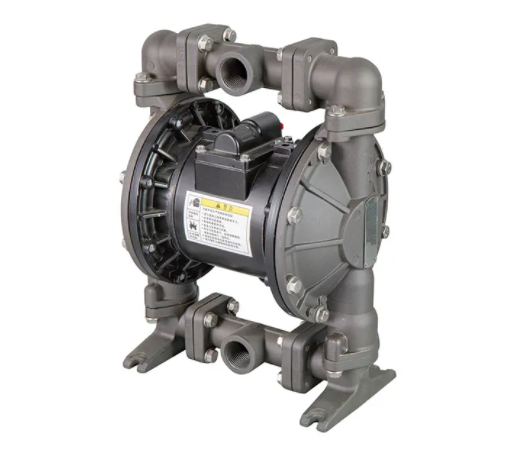Oct. 19, 2023
Mechanical Parts & Fabrication Services
Diaphragm pumps are versatile and essential tools in a variety of industries, providing efficient and reliable fluid transfer capabilities. In particular, 1 inch diaphragm pump are compact yet powerful devices that can handle a wide range of fluids, from water to viscous chemicals. In this article, we'll explore the inner workings of the 1-inch diaphragm pump, highlighting its mechanism, applications, and benefits.

Diaphragm Pump Basics
Before delving into the details of 1-inch diaphragm pumps, it's important to understand the fundamentals behind them. Diaphragm pumps are positive displacement pumps that use reciprocating diaphragms to move fluid. They are known for their ability to handle a variety of fluid types, including abrasive, viscous, and shear-sensitive materials.
1. Diaphragm design and materials
Diaphragm pumps have a flexible diaphragm, usually made of materials such as rubber, thermoplastic or metal. This diaphragm is the heart of the pump and plays a vital role in the fluid transfer process. The diaphragm is mounted in a chamber that divides the pump into two distinct compartments: the suction side and the discharge side.
2. Suction and discharge valves
Each compartment of a diaphragm pump has a set of valves: a suction (inlet) valve and a discharge (outlet) valve. These valves control the flow of fluid into and out of the pump. As the diaphragm flexes, the valves open and close accordingly, allowing fluid to flow through the pump in a pulsating manner.
3. Diaphragm Action
Diaphragms are actuated by a reciprocating mechanism, usually driven by compressed air or a mechanical drive. As the diaphragm moves, it creates a pressure differential between the two compartments, causing fluid to be drawn in on one side and discharged on the other. This action allows the pump to move fluid efficiently.
How 1-inch diaphragm pumps work
A 1-inch diaphragm pump is a special type of diaphragm pump equipped with a 1-inch inlet and outlet for fluid transfer. Let's take a closer look at how it works:
1. Fluid intake:
The process begins on the suction side of the pump with the flexible diaphragm in its natural position, creating a vacuum inside the chamber. The suction valve opens and liquid is drawn into the chamber.
2. Diaphragm compression:
When the reciprocating mechanism of the diaphragm is activated, it flexes and compresses the fluid in the chamber. This compression forces the fluid to the discharge side.
3. fluid discharge:
As the diaphragm continues to move, it reaches a point of maximum compression, causing the discharge valve to open. This allows the compressed fluid to leave the pump and be discharged to a desired destination, such as a tank, pipe, or spray equipment.
4. Return Stroke:
After completing the discharge stroke, the diaphragm returns to its original position. This movement creates a vacuum on the discharge side, causing the discharge valve to close and the suction valve to open again. The cycle repeats itself as the diaphragm continues to reciprocate.
Applications for 1 in. diaphragm pumps
With the ability to handle a wide range of fluids and operate under demanding conditions, 1-inch diaphragm pumps are used in a wide variety of industries. Some common applications include:
Chemical industry: 1-inch diaphragm pumps are used to safely and efficiently transfer chemicals, solvents, and abrasive fluids.
Mining: They are used for dewatering, slurry transfer and handling corrosive materials in mining operations.
Oil and Gas: These pumps are used to transfer drilling mud, crude oil and wastewater in oil and gas drilling operations.
Agriculture: 1-inch diaphragm pumps are used for spraying pesticides and fertilisers, as well as transferring irrigation water.
Construction: They are used to pump mud, cement slurries and other building materials.
Food and beverage: these pumps handle food-grade liquids and are suitable for conveying beverages, sauces and food ingredients.
Wastewater treatment: diaphragm pumps are used in wastewater treatment plants for sludge treatment and chemical dosing.
Benefits of 1-inch diaphragm pumps
1-inch diaphragm pumps offer a variety of benefits that make them a popular choice for many industries:
1. Versatility: They can handle a wide range of fluids, from clean water to highly viscous and abrasive materials.
2. Self-priming: Diaphragm pumps are self-priming, which means they can lift fluids from a lower level to the pump inlet without the need for external self-priming.
3. Empty run capability: These pumps can operate without damage or overheating during short periods of empty operation, which increases their reliability.
4. Durability: Diaphragm pumps are known for their rugged construction, durable materials and minimal maintenance requirements.
5. No Stall: Reciprocating diaphragm action allows these pumps to handle fluids with high solids content without stalling.
6. Safety: Suitable for handling hazardous and corrosive fluids, providing safe, leak-free transfer.
In summary
The 1-inch diaphragm pump is a versatile and efficient fluid transfer device driven by the reciprocating motion of a flexible diaphragm. Its design and features make it ideal for a variety of applications in different industries, including chemicals, mining, agriculture, and more. Capable of handling a wide range of fluids and with a reputation for durability and safety, the 1-inch diaphragm pump plays a vital role in ensuring the smooth movement of fluids through many industrial processes.
If you are interested in sending in a Guest Blogger Submission,welcome to write for us!
All Comments ( 0 )